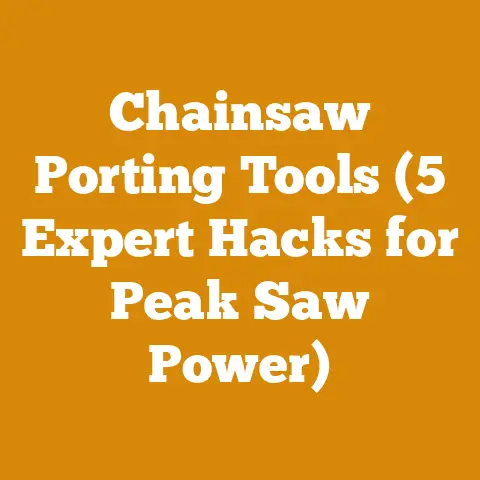DIY Chainsaw Holder for Tractor (5 Pro Tips for Secure Mounting)
Imagine this: It’s a crisp autumn morning, the air smells of pine and damp earth, and I’m heading out to the woodlot on my tractor. But there’s always that slight nagging worry in the back of my mind – where’s the safest place for my chainsaw? Tossing it in the back of the tractor is a recipe for disaster, and constantly climbing down to grab it from the garage is a waste of precious time. That’s when I realized a DIY chainsaw holder for my tractor was more than just a convenience; it was a lifestyle upgrade. It’s about efficiency, safety, and peace of mind. Over the years, I’ve built and refined several different chainsaw holders, learning from my mistakes and successes. In this guide, I’ll share five pro tips for secure mounting, so you can build a holder that keeps your chainsaw safe, accessible, and ready for action.
DIY Chainsaw Holder for Tractor: 5 Pro Tips for Secure Mounting
Building a chainsaw holder for your tractor isn’t just about sticking some metal together. It’s about understanding the forces involved, the environment it will be subjected to, and, most importantly, the safety implications. These five pro tips are the culmination of years of experience, experimentation, and a few near misses (which I’ll gladly share to help you avoid the same pitfalls).
1. Understand Your Tractor and Chainsaw
Before you even think about cutting metal, you need to intimately understand your tractor and your chainsaw. This isn’t just knowing the model number; it’s about the physical dimensions, available mounting points, and the specific tasks you’ll be using the chainsaw for.
-
Tractor Assessment: Walk around your tractor with a measuring tape and a critical eye. Identify potential mounting locations. Look for existing bolt holes, frame members, or areas where you can easily weld or attach a bracket. Consider accessibility. Can you easily reach the chainsaw when seated? Is the location out of the way of other implements or operations? Take detailed measurements of these points – bolt hole diameters, distances between holes, and the thickness of the metal. This data will be crucial for designing your mounting brackets. Also, note the material your tractor’s frame is made of. Most tractors use steel, but knowing the specific type of steel will help you choose the right welding rods or fasteners.
- My Experience: On my old Ford 8N, I initially considered mounting the holder on the rear fender. It seemed like a convenient spot. However, after measuring the fender thickness (it was surprisingly thin) and considering the vibrations it would endure, I realized it wasn’t strong enough. I ended up using the drawbar frame as my primary mounting point, which offered much greater stability.
-
Chainsaw Analysis: Don’t just grab your chainsaw and assume any holder will work. Measure the length of the bar, the width of the engine housing, and the overall weight. This is critical for determining the size and strength of your holder. Also, consider the type of chainsaw you use. A lightweight pruning saw will require a much different holder than a heavy-duty logging saw. Pay close attention to the bar cover. You want a holder that accommodates the cover securely, preventing it from falling off during transport.
- Pro Tip: Create a cardboard template of your chainsaw. This allows you to visualize the holder’s design and placement without risking damage to your actual saw.
-
Data-Driven Design: Gathered data will inform your design choices. For example, if your tractor has existing M10 bolt holes spaced 100mm apart on a 5mm thick steel frame, you’ll know you need brackets with matching M10 bolts and a design that distributes the chainsaw’s weight evenly across the frame. If your chainsaw weighs 15 pounds and has a 20-inch bar, your holder needs to be robust enough to handle that weight and length without bending or breaking.
2. Choosing the Right Materials
The materials you use will determine the durability, longevity, and safety of your chainsaw holder. Don’t skimp on quality here. Remember, this holder will be subjected to vibrations, weather, and the weight of your chainsaw.
-
Steel Selection: Mild steel is the most common and cost-effective option for DIY projects. It’s relatively easy to weld and offers good strength. However, for heavier chainsaws or more demanding applications, consider using high-strength steel, such as A36 steel. This offers significantly greater yield strength and tensile strength, making it more resistant to bending and breaking. The thickness of the steel is also crucial. For most chainsaw holders, I recommend using at least 1/8-inch thick steel for the main brackets and supports. For smaller, lighter chainsaws, you might get away with 1/16-inch steel, but err on the side of caution.
- My Story: I once built a chainsaw holder using thin-walled tubing, thinking it would be lightweight and easy to work with. It looked great, but after a few hours of use, the vibrations caused the tubing to crack at the welds. I had to completely rebuild it using thicker steel. Lesson learned!
-
Fasteners: Use high-quality bolts, nuts, and washers. Grade 5 or Grade 8 bolts are recommended for most applications. These are significantly stronger than standard hardware store bolts. Use lock washers or nylon lock nuts to prevent the fasteners from loosening due to vibration. When choosing bolt sizes, consider the weight of your chainsaw and the thickness of the steel you’re using. As a general rule, M8 or M10 bolts are sufficient for most chainsaw holders.
-
Protective Coatings: Protect your chainsaw holder from rust and corrosion. Painting is a good starting point, but powder coating offers superior durability and resistance to scratches and chips. Galvanizing is another excellent option, especially if you live in a wet or humid climate.
- Case Study: I built two identical chainsaw holders for two different tractors. One I painted with rust-resistant primer and enamel paint, and the other I had powder coated. After two years, the painted holder showed signs of rust, while the powder-coated holder looked as good as new. The extra cost of powder coating was well worth it.
-
Material Specifications:
- Mild Steel: Yield Strength: 36,000 PSI, Tensile Strength: 58,000 PSI
- A36 Steel: Yield Strength: 36,000 PSI, Tensile Strength: 58,000-80,000 PSI
- Grade 5 Bolts: Tensile Strength: 120,000 PSI
- Grade 8 Bolts: Tensile Strength: 150,000 PSI
3. Design for Security and Accessibility
A well-designed chainsaw holder should securely hold your chainsaw while also allowing you to quickly and easily access it when needed. This requires careful consideration of the holder’s shape, locking mechanism, and overall ergonomics.
-
Holder Shape: The shape of the holder should conform to the contours of your chainsaw. A U-shaped holder that cradles the bar and engine housing is a good starting point. Add additional supports to prevent the chainsaw from rocking or shifting during transport. Consider incorporating a slot or channel for the bar cover to slide into, ensuring it stays in place.
- Pro Tip: Use closed cell foam to line the inside of the holder. This will protect your chainsaw from scratches and vibrations.
-
Locking Mechanism: A locking mechanism is essential to prevent your chainsaw from falling out of the holder, especially when traversing rough terrain. Several options are available:
- Spring-Loaded Latch: A simple and effective option. The latch automatically engages when the chainsaw is inserted and can be easily released with one hand.
- Pin and Clip: A more secure option, but requires two hands to operate. A pin is inserted through a hole in the holder and the chainsaw, and a clip is used to secure the pin.
-
Rubber Straps: A versatile option that can accommodate different chainsaw sizes. Rubber straps are stretched over the chainsaw and secured to the holder with buckles or hooks.
-
My Innovation: I designed a locking mechanism that uses a magnetic latch. It’s incredibly easy to use and provides a surprisingly strong hold. I simply insert the chainsaw, and the magnetic latch automatically engages. To release it, I just pull on a lever.
-
Ergonomics: Consider how you will access the chainsaw from the tractor seat. The holder should be positioned at a height and angle that allows you to easily reach and remove the chainsaw without straining your back or arms. Also, think about the direction you want the chainsaw to face. Do you want to grab it by the handle, or do you prefer to slide it out bar-first?
- Case Study: A friend of mine built a chainsaw holder that was positioned too high. He had to stand up on the tractor seat to reach the chainsaw, which was both awkward and dangerous. I helped him redesign the holder to lower it and angle it towards the seat, making it much more accessible.
-
Chain Protection: Exposed chainsaw chains can be dangerous. Design the holder so the chain is completely enclosed by the bar cover when stored. Consider adding an additional guard to prevent accidental contact with the chain.
4. Welding and Fabrication Techniques
If you’re planning to weld your chainsaw holder, it’s essential to have a solid understanding of welding techniques and safety precautions. Even if you’re not a professional welder, you can achieve excellent results with a little practice and the right equipment.
-
Welding Equipment: A MIG (Metal Inert Gas) welder is the most common and versatile option for DIY projects. It’s relatively easy to learn and produces clean, strong welds. A stick welder is another option, but it’s more challenging to use and produces more slag. A TIG (Tungsten Inert Gas) welder is the most precise option, but it’s also the most expensive and requires more skill. Regardless of the type of welder you choose, make sure it’s properly grounded and that you’re using the correct settings for the type and thickness of steel you’re welding.
- Pro Tip: Practice welding on scrap metal before you start working on your chainsaw holder. This will allow you to get a feel for the welder and fine-tune your settings.
-
Welding Techniques: Use proper welding techniques to ensure strong, durable welds. Clean the metal thoroughly before welding to remove any rust, paint, or grease. Use a wire brush or grinder to remove any mill scale. Tack weld the pieces together before welding them completely. This will help prevent distortion. Use a weaving motion to create a wider, stronger weld. Allow the welds to cool slowly to prevent cracking.
-
Alternative Fabrication Methods: If you don’t have access to a welder, you can still build a chainsaw holder using alternative fabrication methods. Bolting, riveting, and using metal adhesives are all viable options. When using bolts, make sure to use a sufficient number of bolts and that they are properly tightened. Rivets offer a strong, permanent connection. Metal adhesives are a good option for joining thin pieces of metal, but they may not be strong enough for heavier chainsaws.
- My Experience: I built a chainsaw holder for a friend who didn’t have a welder. I used a combination of bolts and rivets, and it turned out surprisingly well. It wasn’t as elegant as a welded holder, but it was strong and functional.
-
Safety Precautions: Welding can be dangerous if proper safety precautions are not followed. Always wear a welding helmet with the correct shade lens to protect your eyes from the intense light. Wear welding gloves to protect your hands from burns. Wear a welding jacket or apron to protect your clothing from sparks. Work in a well-ventilated area to avoid inhaling fumes. Keep a fire extinguisher nearby in case of accidents.
5. Mounting and Testing
Once you’ve built your chainsaw holder, it’s time to mount it to your tractor and test its performance. This is a critical step to ensure that the holder is secure, accessible, and doesn’t interfere with other tractor operations.
-
Mounting: Use the mounting points you identified in Step 1. Make sure the holder is securely attached to the tractor frame. Use high-quality bolts, nuts, and washers. Tighten the fasteners to the correct torque specifications. If you’re welding the holder to the tractor frame, make sure to clean the metal thoroughly and use proper welding techniques.
- Pro Tip: Use anti-seize compound on the bolt threads to prevent them from seizing up due to rust and corrosion.
-
Testing: Once the holder is mounted, test its performance with your chainsaw. Insert the chainsaw into the holder and make sure it fits securely. Shake the tractor to simulate vibrations and rough terrain. Check to see if the chainsaw moves or rattles. If it does, tighten the fasteners or add additional supports. Operate the tractor with the chainsaw in the holder and make sure it doesn’t interfere with steering, visibility, or other operations.
- My Embarrassment: I once mounted a chainsaw holder too close to the tractor’s exhaust pipe. After a few minutes of operation, the heat from the exhaust melted the rubber straps that were holding the chainsaw in place. I had to completely relocate the holder.
-
Adjustments: Don’t be afraid to make adjustments to the holder if necessary. You may need to reposition it, add additional supports, or modify the locking mechanism. The goal is to create a holder that is safe, secure, and convenient to use.
-
Regular Inspections: Regularly inspect your chainsaw holder for signs of wear and tear. Check the welds for cracks, the fasteners for looseness, and the protective coatings for damage. Repair any damage promptly to prevent accidents.
Strategic Advantages of a DIY Chainsaw Holder
Beyond the immediate benefits of safety and convenience, a well-designed DIY chainsaw holder offers several strategic advantages:
- Increased Efficiency: Having your chainsaw readily accessible saves time and effort. You can quickly respond to fallen trees or branches without having to run back to the garage or workshop. This is especially valuable when working in remote areas.
- Improved Safety: A secure chainsaw holder reduces the risk of accidents. You don’t have to worry about the chainsaw falling off the tractor or getting damaged during transport. This protects both you and your equipment.
- Enhanced Productivity: By streamlining your workflow and minimizing downtime, a chainsaw holder can significantly increase your overall productivity. You can get more done in less time, which translates to greater profits.
- Customization: Building your own chainsaw holder allows you to customize it to your specific needs and preferences. You can choose the materials, design, and features that work best for you. This is something you can’t get with a commercially available holder.
- Cost Savings: Building your own chainsaw holder can be significantly cheaper than buying a pre-made one. You can save money on materials by using scrap metal or recycled parts.
Practical Next Steps
Ready to build your own chainsaw holder? Here are some practical next steps:
- Gather Your Tools and Materials: Make a list of the tools and materials you’ll need, based on the design you’ve chosen. This might include steel, fasteners, welding equipment, cutting tools, measuring tools, and protective gear.
- Create a Detailed Plan: Draw up a detailed plan of your chainsaw holder, including dimensions, materials, and assembly instructions. This will help you stay organized and avoid mistakes.
- Start Building: Follow your plan carefully and take your time. Double-check your measurements and welds. Don’t be afraid to ask for help if you get stuck.
- Test and Refine: Once you’ve built your chainsaw holder, mount it to your tractor and test its performance. Make any necessary adjustments to ensure it’s safe, secure, and convenient to use.
- Enjoy the Benefits: With your new chainsaw holder in place, you can enjoy the benefits of increased efficiency, improved safety, and enhanced productivity.
Building a DIY chainsaw holder for your tractor is a rewarding project that can significantly improve your wood processing or firewood preparation workflow. By following these five pro tips, you can create a holder that is safe, secure, and tailored to your specific needs. So, grab your tools, put on your safety gear, and get building! You will not regret the investment in time and effort, as it will pay off in efficiency, safety, and peace of mind for years to come.






